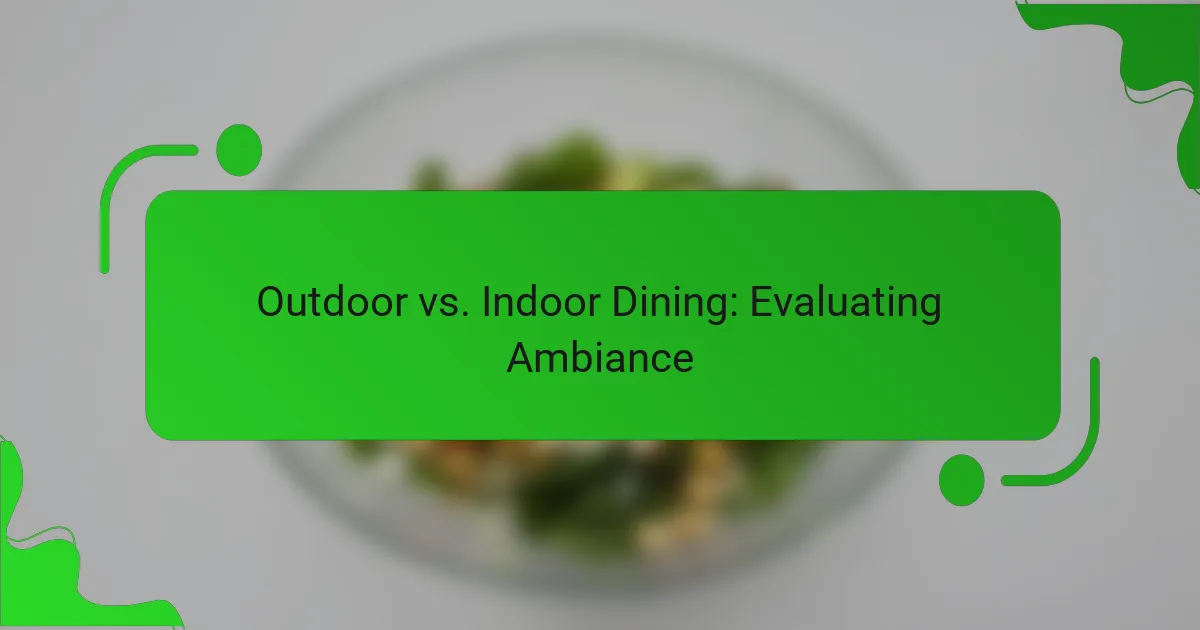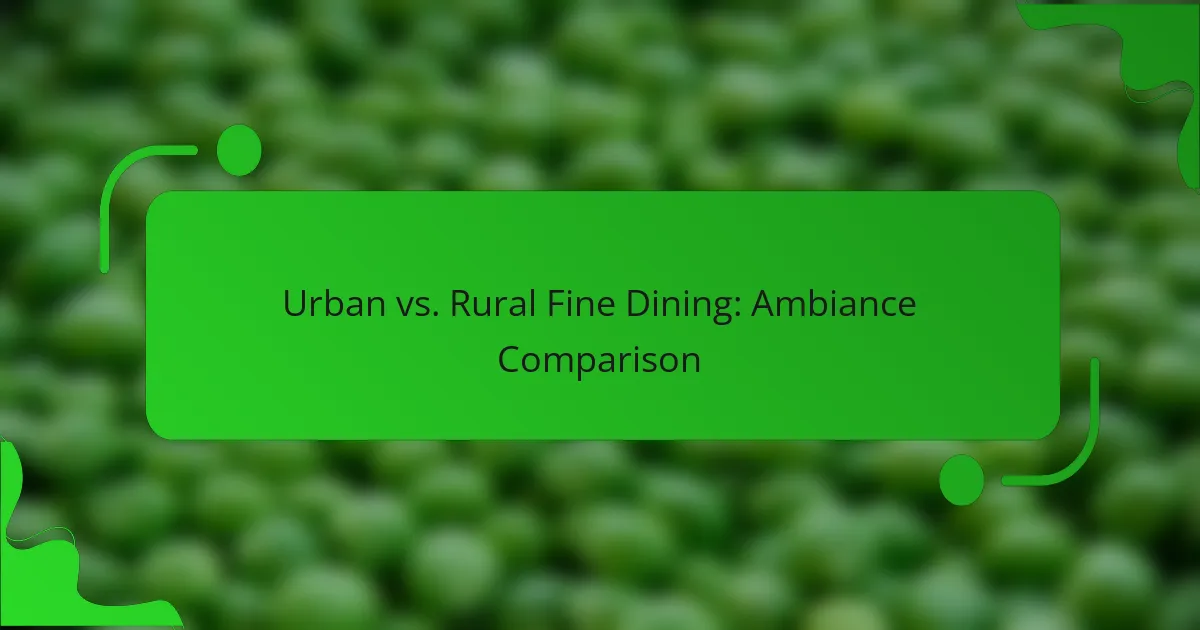When it comes to dining out, the choice between outdoor and indoor settings significantly influences the overall experience. Outdoor dining provides a vibrant atmosphere enriched by nature, while indoor dining offers climate control and a more intimate ambiance. Each option caters to different preferences, making the decision a matter of personal taste and desired atmosphere.

What are the benefits of outdoor dining in urban areas?
Outdoor dining in urban areas offers unique advantages, enhancing the overall dining experience. Patrons enjoy a vibrant atmosphere, increased space for social interactions, and the refreshing benefits of nature.
Enhanced ambiance and atmosphere
Outdoor dining creates a lively ambiance that indoor settings often lack. The sights and sounds of the city, combined with natural elements, contribute to a more enjoyable meal. Restaurants can enhance this experience with decorative lighting, outdoor seating arrangements, and greenery.
Choosing a venue with a view, such as a rooftop or patio overlooking a park, can significantly elevate the dining experience. Consider visiting during sunset for a picturesque backdrop that adds to the overall atmosphere.
Increased space for social distancing
Outdoor dining allows for greater spacing between tables, making it easier to maintain social distancing. This is particularly important in urban areas where indoor spaces can become crowded. Many restaurants have adapted their outdoor seating to accommodate more guests while ensuring safety.
When selecting a restaurant, check if they have expanded their outdoor seating options. Look for venues that offer ample space between tables, which can enhance comfort and safety during busy dining hours.
Access to natural light and fresh air
Dining outdoors provides the benefits of natural light and fresh air, which can enhance mood and overall well-being. Exposure to sunlight can improve vitamin D levels, while fresh air can create a more pleasant dining experience.
Consider visiting restaurants with shaded outdoor areas or those that offer umbrellas for sunny days. This allows you to enjoy the outdoors while staying comfortable, making your dining experience more enjoyable.

What are the advantages of indoor dining in cities?
Indoor dining in cities offers several advantages, including climate control, consistent service, and a quieter atmosphere. These factors enhance the overall dining experience, making it more enjoyable regardless of external conditions.
Climate control and comfort
Indoor dining provides a stable environment, allowing patrons to enjoy their meals without the discomfort of extreme weather. Restaurants can maintain a comfortable temperature year-round, whether it’s a hot summer day or a chilly winter evening.
This climate control is particularly beneficial in urban areas where outdoor conditions can be unpredictable. Diners can relax without worrying about rain, wind, or excessive heat, making indoor spaces more appealing for long meals or special occasions.
Consistent service and food quality
Indoor dining typically ensures a higher level of service and food quality. Staff can focus on providing attentive service without the distractions that outdoor settings may present, such as passing traffic or nearby construction.
Additionally, indoor kitchens are less affected by outside elements, which can impact food preparation and presentation. This consistency helps maintain the restaurant’s standards, leading to a more satisfying dining experience.
Reduced noise from outdoor elements
Dining indoors significantly reduces noise pollution from traffic, construction, and other outdoor activities. This quieter environment allows for better conversation and a more relaxed atmosphere, enhancing the overall enjoyment of the meal.
In cities where noise levels can be high, indoor dining provides a refuge from distractions. Patrons can engage in meaningful conversations without raising their voices, making it an ideal choice for business meetings or intimate gatherings.

How do outdoor and indoor dining options compare in terms of ambiance?
Outdoor and indoor dining each offer distinct ambiance experiences that cater to different preferences. Outdoor dining typically features a lively atmosphere with natural elements, while indoor dining tends to create a more intimate and cozy environment.
Outdoor dining offers a vibrant atmosphere
Dining outdoors often immerses guests in a lively setting, enhanced by fresh air and natural surroundings. This option is particularly appealing during pleasant weather, where the sights and sounds of nature can elevate the dining experience.
Restaurants with outdoor seating may incorporate elements like gardens, patios, or scenic views, which can significantly enhance the overall ambiance. Considerations such as seasonal weather and local noise levels can impact your enjoyment, so it’s wise to check forecasts and choose times when conditions are favorable.
Indoor dining provides a cozy and intimate setting
Indoor dining typically offers a warm and inviting atmosphere, ideal for intimate gatherings or special occasions. The controlled environment allows for consistent comfort, with features like soft lighting and comfortable seating enhancing the experience.
Many indoor venues use decor, music, and layout to create a unique ambiance that encourages conversation and relaxation. When selecting an indoor dining option, consider the restaurant’s layout and noise levels, as these factors can greatly influence your comfort and enjoyment.

What factors should you consider when choosing between outdoor and indoor dining?
When deciding between outdoor and indoor dining, consider the ambiance, comfort, and overall experience you desire. Factors such as weather, cuisine type, and health regulations play a significant role in this choice.
Weather conditions and seasonality
Weather significantly impacts the dining experience. Outdoor dining is often ideal in pleasant weather, such as sunny days in spring and summer, while harsh conditions like rain or cold can make it uncomfortable. Seasonal changes can also affect the availability of outdoor seating, with many restaurants offering heated patios in cooler months.
Check local forecasts before making plans. If the weather is unpredictable, consider venues that provide both options, allowing you to switch between indoor and outdoor seating as needed.
Type of cuisine and dining experience
The type of cuisine can influence your choice of dining environment. For example, casual meals like barbecues or picnics are often better suited for outdoor settings, while fine dining experiences may be enhanced by the ambiance of an indoor restaurant. Additionally, certain cuisines may be more enjoyable outdoors, such as seafood or grilled dishes.
Think about the overall dining experience you want. Outdoor dining can offer a relaxed atmosphere, while indoor dining often provides a more intimate setting, which may be preferable for special occasions.
Health and safety regulations
Health and safety regulations can vary by location and impact your dining choice. Many areas have specific guidelines regarding outdoor dining, especially concerning food safety and sanitation. Ensure that the restaurant complies with local health regulations, particularly if they are serving food outdoors.
Stay informed about any current health advisories or restrictions that may affect your dining experience. For instance, during health crises, some regions may limit outdoor seating capacity or require additional safety measures, which could influence your decision.

How does location influence the dining ambiance?
The location of a dining establishment significantly impacts the overall ambiance, affecting factors like noise levels, scenery, and clientele. Urban settings often provide a vibrant atmosphere, while suburban areas may offer a more relaxed and spacious environment.
Urban vs. suburban dining experiences
Urban dining typically features a lively atmosphere with bustling crowds and diverse culinary options. Restaurants in cities often capitalize on foot traffic and cultural events, creating a dynamic experience that attracts a wide range of patrons.
In contrast, suburban dining experiences tend to be quieter and more family-oriented. These establishments often have larger spaces, allowing for outdoor seating and a more relaxed pace, appealing to those seeking a casual meal away from the city’s hustle.
Proximity to parks and natural settings
Restaurants located near parks or natural settings can enhance the dining experience by offering scenic views and a tranquil atmosphere. Outdoor seating in these areas allows diners to enjoy fresh air and greenery, which can elevate the overall enjoyment of the meal.
Choosing a restaurant close to nature can also provide opportunities for activities before or after dining, such as walking or picnicking. This proximity can be particularly appealing for families and groups looking to combine dining with leisure activities.

What are the emerging trends in dining ambiance?
Emerging trends in dining ambiance focus on enhancing the overall experience through innovative designs, technology integration, and sustainability. As restaurants adapt to changing consumer preferences, these elements play a crucial role in attracting and retaining customers.
Integration of technology in outdoor settings
Technology is increasingly being integrated into outdoor dining environments to improve customer experience. Features such as digital menus, contactless payment systems, and interactive tables create a modern atmosphere while ensuring convenience and safety.
Restaurants are also utilizing smart lighting and sound systems to enhance the ambiance. For example, adjustable lighting can set the mood for different times of the day, while sound systems can provide background music tailored to the dining experience.
Innovative indoor designs enhancing experience
Indoor dining spaces are evolving with innovative designs that prioritize comfort and aesthetics. Open layouts, biophilic design elements, and customizable seating arrangements create inviting environments that encourage longer stays and repeat visits.
Restaurants are incorporating unique decor and art installations to create memorable experiences. For instance, themed interiors or locally sourced artwork can provide a sense of place and connection to the community, enhancing the overall dining experience.
Focus on sustainability in dining environments
Sustainability is becoming a key consideration in dining ambiance, with many establishments adopting eco-friendly practices. This includes using sustainable materials for furniture and decor, as well as implementing waste reduction strategies.
Restaurants are also focusing on sourcing local ingredients, which not only supports the community but also reduces the carbon footprint associated with transportation. By promoting these practices, establishments can appeal to environmentally conscious customers and enhance their brand image.

How can restaurants optimize their outdoor and indoor dining spaces?
Restaurants can enhance their outdoor and indoor dining areas by focusing on ambiance, comfort, and functionality. Key factors include layout, decor, and climate considerations that cater to customer preferences.
Creating a Comfortable Atmosphere
To create a comfortable atmosphere, restaurants should consider seating arrangements, lighting, and temperature control. For outdoor spaces, providing shade with umbrellas or awnings and using heaters for cooler evenings can significantly improve guest comfort.
Indoor dining should prioritize adequate ventilation and temperature regulation. Utilizing soft lighting and sound-absorbing materials can help create a cozy environment, making guests feel more relaxed and willing to linger.
Designing for Flexibility
Flexibility in design allows restaurants to adapt their spaces for different occasions and seasons. Outdoor areas can be equipped with movable furniture to accommodate varying group sizes, while indoor layouts can include partitioning options for private dining experiences.
Consideration of seasonal decor can also enhance the dining experience. For example, using plants and flowers in spring and summer, while incorporating warm textiles in fall and winter, can keep the ambiance fresh and inviting.
Enhancing the Dining Experience
Enhancing the dining experience involves integrating elements that engage the senses. Outdoor dining can benefit from natural elements like greenery and water features, while indoor spaces can showcase art or unique decor to create visual interest.
Offering a diverse menu that complements the dining environment is also crucial. For instance, lighter fare may be more appealing in outdoor settings during warm weather, while hearty dishes might attract guests indoors during colder months.



